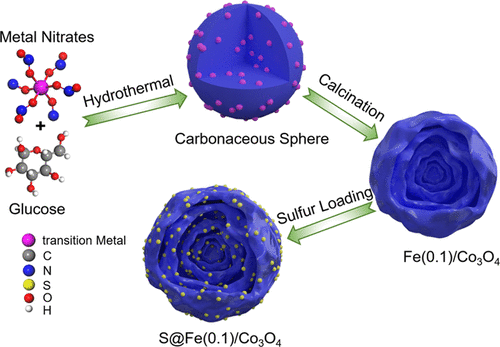当前位置:
X-MOL 学术
›
ACS Appl. Mater. Interfaces
›
论文详情
Our official English website, www.x-mol.net, welcomes your
feedback! (Note: you will need to create a separate account there.)
Defect-Rich Multishelled Fe-Doped Co3O4 Hollow Microspheres with Multiple Spatial Confinements to Facilitate Catalytic Conversion of Polysulfides for High-Performance Li-S Batteries.
ACS Applied Materials & Interfaces ( IF 8.3 ) Pub Date : 2020-02-11 , DOI: 10.1021/acsami.9b21853 Wenjuan Wang 1, 2 , Yan Zhao 1, 2 , Yongguang Zhang 1, 2 , Jiayi Wang 2 , Guoliang Cui 2 , Mingjun Li 2 , Zhumabay Bakenov 3 , Xin Wang 1
ACS Applied Materials & Interfaces ( IF 8.3 ) Pub Date : 2020-02-11 , DOI: 10.1021/acsami.9b21853 Wenjuan Wang 1, 2 , Yan Zhao 1, 2 , Yongguang Zhang 1, 2 , Jiayi Wang 2 , Guoliang Cui 2 , Mingjun Li 2 , Zhumabay Bakenov 3 , Xin Wang 1
Affiliation

|
Over the past decade, lithium-sulfur (Li-S) batteries have been thought of as promising alternatives for the new generation of battery systems. Although the Li-S batteries possess high-theoretical energy density (2600 Wh kg-1) and capacity (1675 mAh g-1), the problems of poor electron and ion conduction, volumetric expansion, and sulfur immobilization greatly impede the wide applicability of Li-S batteries. Herein, a defect-rich multishelled Co3O4 microsphere structure doped with Fe was synthesized via a one-step hydrothermal method and subsequent thermal treatment. The unique multishelled structure provides multiple spatial confinements for lithium polysulfides trapping and buffering the volume variation during cycling. Moreover, the rich oxygen defect designed by controlled Fe doping can provide numerous catalytic sites for polysulfide redox reactions. Attributed to the synergistic effect of structural design and oxygen-defect fabrication, the sulfur composite electrode delivers a notable cycle performance, presenting a much lower capacity fading of 0.017% per cycle over 1000 cycles at 1 C and an excellent rate capability of 571.3 mAh g-1 at 5 C. This work proposes a potential approach for designing a transition metal oxide-based multishelled hollow structure combined with oxygen defect, which also offers a new perspective on high-performance Li-S batteries.
中文翻译:

具有多个空间限制的缺陷丰富的多壳掺铁Co3O4空心微球,可促进多硫化物催化转化为高性能Li-S电池。
在过去的十年中,锂硫(Li-S)电池被认为是新一代电池系统的有前途的替代品。尽管Li-S电池具有较高的理论能量密度(2600 Wh kg-1)和容量(1675 mAh g-1),但电子和离子导电性差,体积膨胀和固定化硫的问题极大地阻碍了锂离子电池的广泛应用。锂电池。在此,通过一步水热法和随后的热处理合成了掺有Fe的,富含缺陷的多壳Co3O4微球结构。独特的多壳结构为多硫化锂的捕获和缓冲循环过程中的体积变化提供了多个空间限制。此外,通过控制铁掺杂设计的富氧缺陷可以为多硫化物氧化还原反应提供许多催化位点。归因于结构设计和氧缺陷制造的协同作用,硫复合电极具有显着的循环性能,在1 C的1000次循环中,每循环的0.017%的容量衰落要低得多,并且具有出色的倍率能力571.3 mAh g在5 C时为-1。这项工作为设计结合氧缺陷的过渡金属氧化物基多壳空心结构提供了一种可能的方法,这也为高性能Li-S电池提供了新的视角。
更新日期:2020-02-21
中文翻译:

具有多个空间限制的缺陷丰富的多壳掺铁Co3O4空心微球,可促进多硫化物催化转化为高性能Li-S电池。
在过去的十年中,锂硫(Li-S)电池被认为是新一代电池系统的有前途的替代品。尽管Li-S电池具有较高的理论能量密度(2600 Wh kg-1)和容量(1675 mAh g-1),但电子和离子导电性差,体积膨胀和固定化硫的问题极大地阻碍了锂离子电池的广泛应用。锂电池。在此,通过一步水热法和随后的热处理合成了掺有Fe的,富含缺陷的多壳Co3O4微球结构。独特的多壳结构为多硫化锂的捕获和缓冲循环过程中的体积变化提供了多个空间限制。此外,通过控制铁掺杂设计的富氧缺陷可以为多硫化物氧化还原反应提供许多催化位点。归因于结构设计和氧缺陷制造的协同作用,硫复合电极具有显着的循环性能,在1 C的1000次循环中,每循环的0.017%的容量衰落要低得多,并且具有出色的倍率能力571.3 mAh g在5 C时为-1。这项工作为设计结合氧缺陷的过渡金属氧化物基多壳空心结构提供了一种可能的方法,这也为高性能Li-S电池提供了新的视角。





















































 京公网安备 11010802027423号
京公网安备 11010802027423号